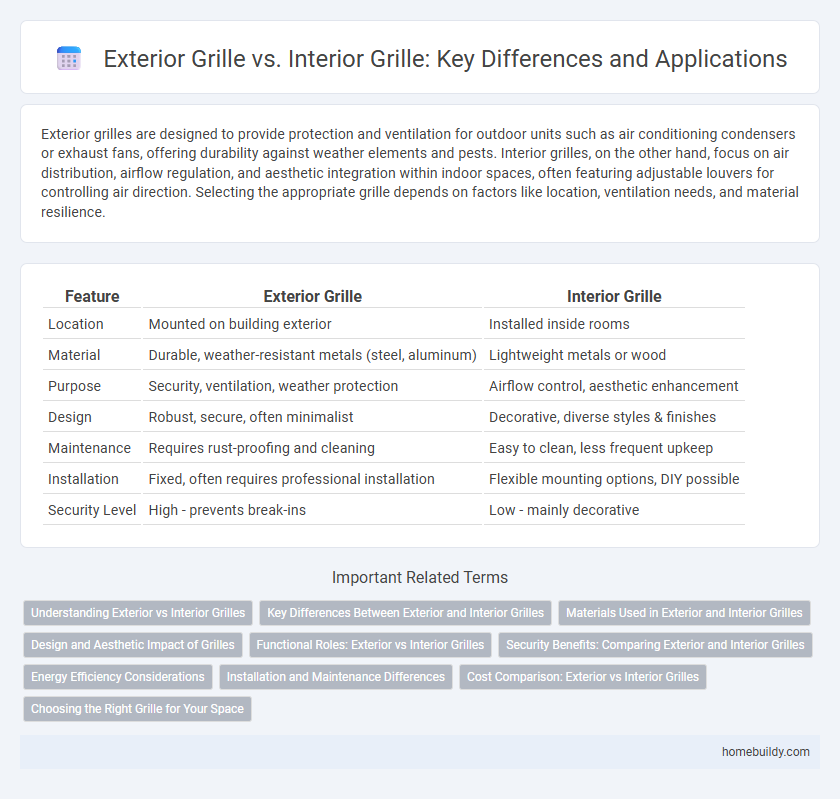Exterior grilles are designed to provide protection and ventilation for outdoor units such as air conditioning condensers or exhaust fans, offering durability against weather elements and pests. Interior grilles, on the other hand, focus on air distribution, airflow regulation, and aesthetic integration within indoor spaces, often featuring adjustable louvers for controlling air direction. Selecting the appropriate grille depends on factors like location, ventilation needs, and material resilience.
Table of Comparison
| Feature | Exterior Grille | Interior Grille |
|---|---|---|
| Location | Mounted on building exterior | Installed inside rooms |
| Material | Durable, weather-resistant metals (steel, aluminum) | Lightweight metals or wood |
| Purpose | Security, ventilation, weather protection | Airflow control, aesthetic enhancement |
| Design | Robust, secure, often minimalist | Decorative, diverse styles & finishes |
| Maintenance | Requires rust-proofing and cleaning | Easy to clean, less frequent upkeep |
| Installation | Fixed, often requires professional installation | Flexible mounting options, DIY possible |
| Security Level | High - prevents break-ins | Low - mainly decorative |
Understanding Exterior vs Interior Grilles
Exterior grilles are designed to withstand weather elements, using durable materials like aluminum or stainless steel to provide security and ventilation for outdoor spaces. Interior grilles prioritize aesthetic appeal and airflow within living spaces, often crafted from wood or decorative metals to complement interior design. Understanding the differences between exterior and interior grilles helps in selecting the right type for functionality, durability, and style.
Key Differences Between Exterior and Interior Grilles
Exterior grilles are designed with durable, weather-resistant materials like aluminum or stainless steel to withstand elements such as rain, wind, and UV exposure, while interior grilles typically use lighter materials like wood or plastic for aesthetic appeal and airflow regulation. Exterior grilles often feature robust protective coatings and security enhancements to prevent debris and intrusion, whereas interior grilles prioritize design integration with home decor and ease of maintenance. The installation and size requirements also differ significantly, with exterior grilles being larger and more securely fixed to building facades compared to the smaller, lightweight, and removable interior grilles.
Materials Used in Exterior and Interior Grilles
Exterior grilles are commonly made from durable materials such as stainless steel, aluminum, and wrought iron to withstand harsh weather conditions and resist corrosion. Interior grilles often utilize lighter materials like wood, plastic, and decorative metal alloys to complement indoor aesthetics while providing ventilation. The choice of materials directly influences the grille's longevity, maintenance needs, and visual appeal in both exterior and interior applications.
Design and Aesthetic Impact of Grilles
Exterior grilles serve as a prominent architectural feature, enhancing building facades with durable materials like aluminum or steel that withstand weather while providing security and style. Interior grilles focus on subtle elegance, often crafted from wood or decorative metals, contributing to ventilation and visual appeal without overwhelming the room's decor. The choice between exterior and interior grilles significantly impacts overall design harmony, balancing functionality with aesthetic priorities tailored to specific spatial contexts.
Functional Roles: Exterior vs Interior Grilles
Exterior grilles serve primarily as protective barriers, shielding HVAC systems from debris, weather elements, and potential pests while allowing optimal airflow. Interior grilles focus on air distribution and aesthetic integration within living spaces, enhancing comfort by directing airflow efficiently without compromising design. Both types are essential for maintaining HVAC system performance and indoor air quality, with exterior grilles emphasizing durability and protection and interior grilles prioritizing controlled ventilation and style.
Security Benefits: Comparing Exterior and Interior Grilles
Exterior grilles provide robust security by acting as a physical barrier against forced entry, designed with heavy-duty materials and tamper-resistant features to deter intruders effectively. Interior grilles, while offering an added layer of protection, focus more on preventing unauthorized access after entry points are breached, often featuring decorative designs that blend with interior aesthetics. Both types enhance security, but exterior grilles deliver primary defense by securing the building's perimeter, whereas interior grilles serve as a secondary safeguard, reinforcing overall protection.
Energy Efficiency Considerations
Exterior grilles serve as the first line of defense against environmental elements, reducing heat gain and loss by blocking direct sunlight and insulating against wind, which enhances overall energy efficiency. Interior grilles, installed inside the building envelope, primarily facilitate airflow control without significantly impacting thermal insulation but contribute to efficient heating and cooling distribution. Opting for exterior grilles with materials designed for solar reflectance and durability improves energy savings more effectively compared to interior grilles alone.
Installation and Maintenance Differences
Exterior grilles require robust materials such as aluminum or stainless steel to withstand weather exposure, making installation more complex due to sealing and waterproofing needs. Interior grilles typically use lighter materials like wood or plastic, allowing for easier installation and simpler maintenance routines such as dusting or repainting. Maintenance of exterior grilles involves regular inspection for rust or corrosion, while interior grilles primarily focus on cleanliness and avoiding damage from household wear.
Cost Comparison: Exterior vs Interior Grilles
Exterior grilles typically cost more than interior grilles due to their need for durable, weather-resistant materials like stainless steel or aluminum, which can withstand harsh environmental conditions. Interior grilles are often made from less expensive materials such as plastic or lightweight metals, reducing overall cost while still providing functional airflow and aesthetics. Installation for exterior grilles may also incur higher labor costs because of the complexity and safety measures required for outdoor mounting, compared to the simpler installation process for interior grilles.
Choosing the Right Grille for Your Space
Exterior grilles require durable materials like aluminum or stainless steel to withstand weather conditions, while interior grilles prioritize aesthetic appeal and airflow control. Selecting the right grille depends on factors such as location, ventilation needs, and design preferences to ensure optimal performance and visual harmony. Proper sizing and finish enhance both functionality and integration within the space's architectural style.
exterior grille vs interior grille Infographic

 homebuildy.com
homebuildy.com